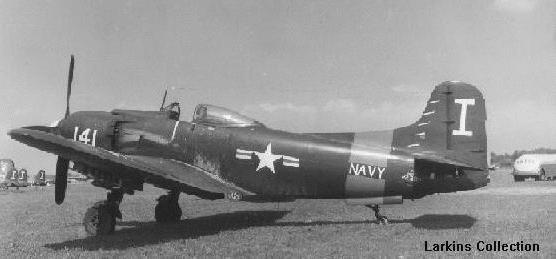
Martin AM-1 Mauler


|
| This photograph may not be used or published, neither commercially nor for other purposes, in any form, including but not restricting to the Internet, magazines and books, without the photographer's permission. For all inquiries please contact the photographer by e-mail or by other means. |
| Type | Attack bomber |
| Crew | One |
| Engine | One P&W R-4360-4W |
| Pistons | 28 |
| Horsepower | 3000 |
| Max. Speed | 367 mph |
| Cruise Speed | 189 mph |
| Ceiling | 30,500 ft. |
| Range | 1800 miles |
| Empty Wt. | 15,275 lb. |
| Loaded Wt. | 24,145 lb.. |
| Wingspan | 50 ft. 1 in. |
| Length | 40 ft. 7.63 in. |
| Height (wings folded) | 11 Ft. 10 in. (16 ft. 10 in.) |
| Wing Area | 496 sq. ft. |
| Armament | Four 20 mm cannon in wings.
Up to 6,000 lb. of assorted bombs, rockets or torpedoes |
| Number Delivered | 149 |
Martin 210, XBTM-1, AM-1 Mauler Navy Attack Plane
After differentiating between torpedo and dive bombers during the 1930's, the Navy decided in 1943 to go back to the "three purpose plane" category used for the T3M and T4M back in the twenties. The new "Bomber-Torpedo" (BT) planes, however, would be single seaters. Experience had shown that pilots could aim bombs or torpedoes and even navigate with radio aids, while powerful new piston engines (and later jets) provided enough speed to forgo a rear gunner. Development of the new type was assigned to several traditional Navy suppliers - Douglas, Grumman, Curtiss, and Martin - and to newcomer Kaiser Fleetwings, operating in the old Keystone plant in Bristol, Pennsylvania. After considering a liquid cooled engine, Martin decided to power its entry with the larger of the two "monster" radials, Pratt and Whitney's four row, 28 cylinder R-4360 "corncob." A contract was signed in January 1944 for two prototype XBTM-1's. Martin dubbed the plane "Mauler."
With work on the B-26 ending, Martin's engineering department was able to move fast. A mockup was ready within a month and the first Mauler flying in August. Looking ahead to desperate battles off the Japanese coast, the Navy ordered 750 of them on January 15, 1945. But then problems arose. The sheer size of the plane and engine made the Mauler difficult for the pilot to control; a complicated hydraulic assist system had to be added. A number of other items had to be redesigned, including the propeller spinner, wing dihedral, and dorsal fin. The torque of the big engine was so strong that it was decided to compensate by offsetting it two degrees to the right of the plane's centerline.
Redesign lasted until early 1947, by which time the order had been cut to only 99 planes, now designated AM-1 in the Navy's new attack classification. By this time the rival Douglas AD-1 Skyraider, which used the somewhat smaller and simpler 18 cylinder Wright R-3350 engine, was entering squadron service. The Mauler, meanwhile, encountered still more problems in its carrier trials. The planes' tails vibrated violently after hooking arresting wires; in one landing the whole rear section of the fuselage ripped off. Eventually a "roller hook" that dissipated sideways stress when engaging the wires was designed to solve the problem, but another year was lost.
In March 1948 "Able Mabels" entered service with four attack squadrons, mostly aboard the new USS Midway. In May, the Navy ordered another fifty planes. As these emerged in 1949 Martin test pilot O.E. "Pat" Tibbs began flying them with remarkable loads. In April 1949 he took up a Mauler carrying three 2,200 pound torpedoes, twelve 500 pound bombs, and 800 rounds of ammunition for the wing mounted 20 mm cannons. The payload of 10,648 pounds set an unofficial record for single engine planes. With the fleet, though, the Maulers proved difficult to land safely aboard even the Midway's 986 foot flight deck. One squadron commander nicknamed his AM's as "Awful Monsters." Although unable to match the Mauler's weight records, the Douglas "Able Dogs" were easier to fly and maintain; they were to serve on into the 1960's. In 1950 the Maulers were reassigned to naval reserve squadrons flying from inland concrete runways.
Eighteen Maulers were delivered as electronic countermeasures planes, AM-1Q's. An electronics operator sat uncomfortably in a windowless compartment behind the pilot, equipped with black boxes and a chaff chute. AM-1Q's served mostly with Composite Squadron Four, based at Atlantic City, from which they were detached to other units. The last active duty Mauler was in service with VC-4 in October 1950; reserve units used them until 1953. BuAir 122397, the Mauler with the weight-lifting record, is preserved at the National Museum of Naval Aviation in Pensacola; parts of three others exist in the collections of the Bradley and Pate air museums and the Confederate Air Force.
|
Glenn L. Martin Aviation Museum |
Email:
Web Master
Copyright © 1999NASGIVM All rights reserved.
Revised: June 30, 2010